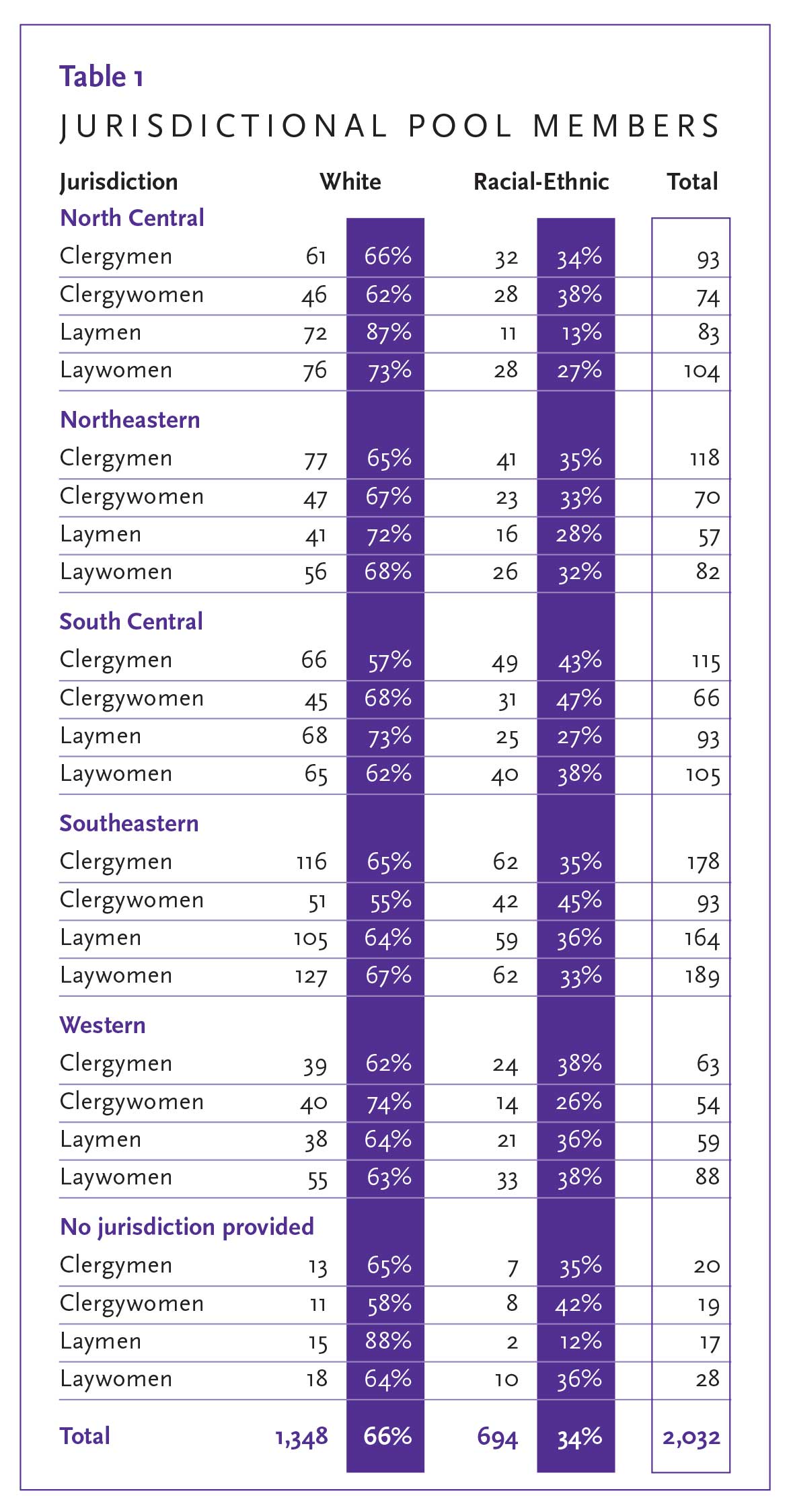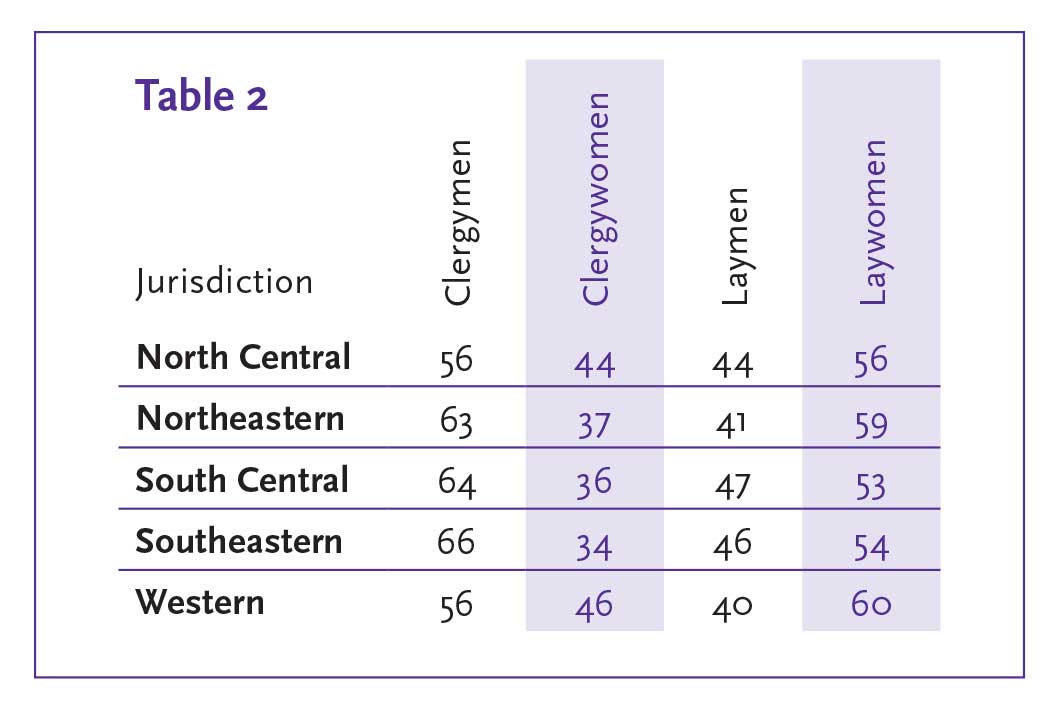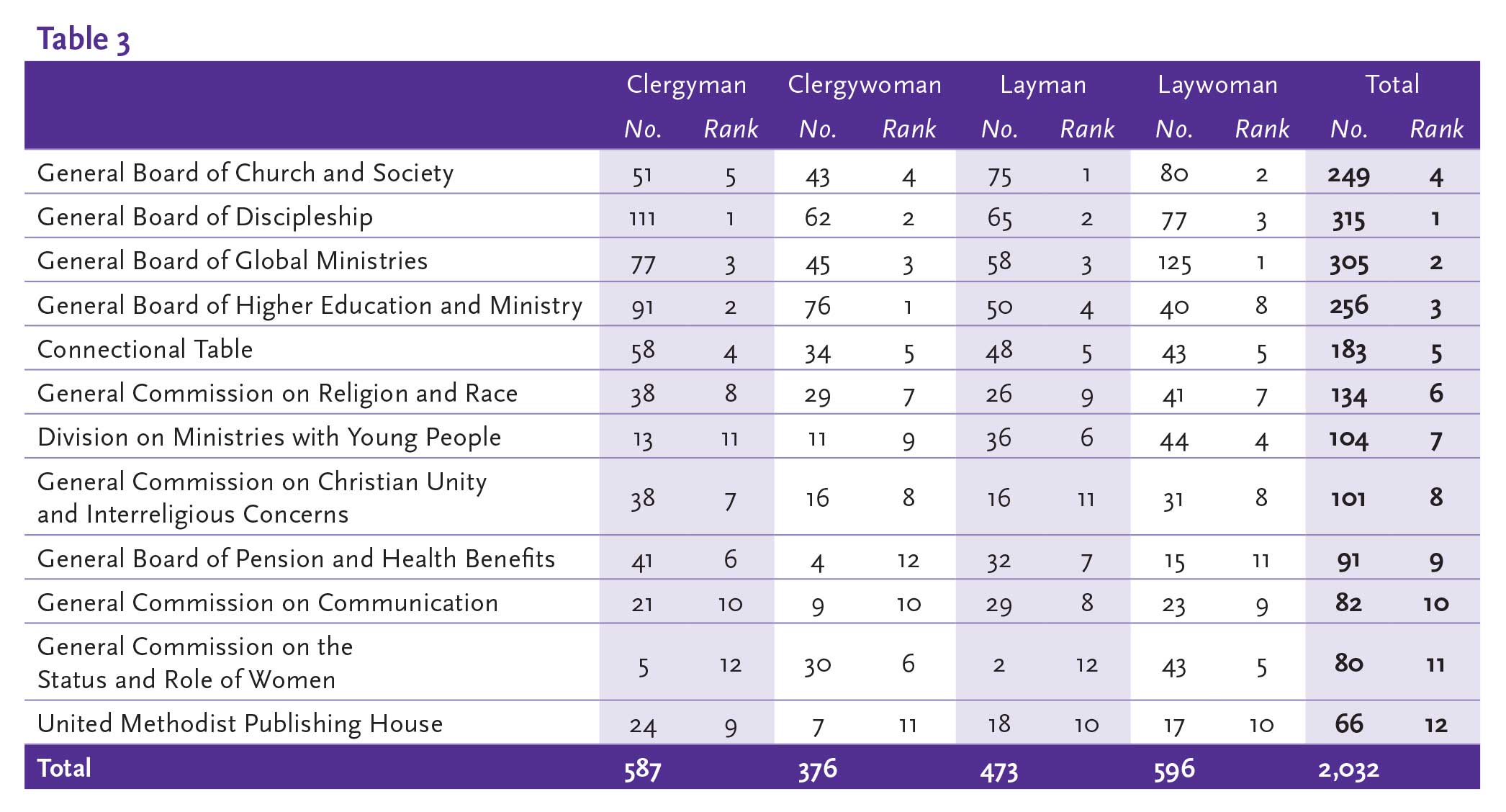Are U.S. regions recommending an inclusive slate of representatives to churchwide agencies?
By Craig This and Elaine May
The jurisdictional pool is the collection of persons from which the jurisdictional nominating committees select people to serve as board members of the various agencies of The United Methodist Church. (The General Council on Finance and Administration, General Commission on United Methodist Men, and General Commission on Archives and History select their board members in a different manner as prescribed by the Book of Discipline.)
Laywomen represented the largest group in the 2008 U.S. jurisdictional pool, with 596 persons. The remaining groups are 587 clergymen, 473 laymen, and 376 clergywomen. Therefore, women comprise 48% (972) of the jurisdictional pool and men make up 52% (1,060) of the jurisdictional pool (see Table 1). The jurisdictional pool provides unique insight into the board membership of the general agencies, and the number of women and people of color at these decision-making tables is directly tied to how aggressively each region is recruiting and assigning a fully inclusive slate to each agency.

Gender
The 52%-48% split of males to females in the 2008 jurisdictional pool mirrors the overall percentages in the five U.S. jurisdictions. Only two jurisdictions, North Central (51%) and Western (54%), had a greater percentage of women than men in their 2008 pools.
The split along lay and clergy lines also generally reflects the overall jurisdictional percentages. The Western Jurisdiction has the largest percentage of laywomen at 60%, followed closely by Northeastern at 59%. The Southeastern Jurisdiction has the smallest percentage of clergywomen at 34% (see Table 2).

Race/ethnicity
Racial-ethnic women, lay and clergy, comprised 17%, or 350, of the total jurisdictional pool, and 36% of the total number of women in the jurisdictional pool (see Table 1).
One notable exception is the Western Jurisdiction, which has only one African-American clergywoman in the jurisdictional pool. Likewise, with the exception of Pacific Islanders, most racial-ethnic groups have representation in each jurisdiction. (For more detailed information, please visit www.gcsrw.org).
There are, in fact, sufficient numbers of women and people of color in the pool to offer gender and racial parity at the agency power tables. Why, then, are women and racial-ethnic persons underrepresented on many agency boards?
Where do they want to serve?
Equitable representation is not just a matter of adequate numbers, but also is affected by the agencies people in the pool choose to serve. Most members of the pool, across categories of race and gender, select as their first four choices for placement General Board of Church and Society, General Board of Discipleship, General Board of Global Ministries, and General Board of Higher Education and Ministry (Table 3).
Most clergymen rank the Connectional Table as their fourth choice and drop the General Board of Church and Society to fifth. Overall, laywomen rank Division on Young People as their fourth choice, and the General Board of Higher Education drops to eighth.

Jurisdictional pool
Again, Table 3 indicates that women are willing to serve on each board of an agency. However, when tracking by race-ethnicity and gender, some agencies have few or no women and people of color ranking them as first choice. In fact, several agencies had no laywomen or clergywomen who ranked them their first choice for the 2009-12 term. Likewise, laymen and clergymen did not list some of the agencies as their first choice.
Conclusion
Why, then, don’t more individuals wish to serve on specific boards and agencies? Why is it that most individuals wish to serve on the four general boards? Has the church stigmatized and labeled the work of the commissions (e.g., Status and Role of Women and Religion and Race), such that people do not ascribe the same prestige and urgency to serving on those boards?
Or do the nominating committees within the denomination—or at least certain jurisdictions— pigeon-hole members of the pool, so that men do not understand that they, too, are needed on the General Commission on the Status and Role of Women, and that white people are needed on the General Commission on Religion and Race?
True, some may not feel called to serve on a particular board or commission. Other individuals may feel that their time and talents are best served within a particular board or commission. Yet, in looking at the choices, it must be asked: When it comes to serving the general church, do individuals approach that work with an open heart and open mind and truly believe, “Here I am, Lord, send me?”
A challenge for annual conference clergywomen’s groups, United Methodist Women’s groups, women of color networks and COSROWs is to make sure that we are urging women to seek out new opportunities for service and learning on all agencies, and to make sure that agencies are seeking out diversity through their additional nominating process (see sidebar). It will also help if these groups help orient women and people of color who are new to church leadership about the work of all agencies and how their gifts can enhance the mission of every church agency.
Craid This is data analyst in the Department of
Institutional Research at Wright State University in Ohio.
Elaine May is assistant general secretary of GCSRW
After the jurisdictions meet and select their slate of persons for each general agency, each jurisdiction designates one clergy, one laywoman and layman who has been elected to a general agency or Connectional Table to nominate additional members of that general agency or council. The 15 members (three from each jurisdiction) are the committee to nominate additional members for that agency. The number of additional members is allocated by the secretary of General Conference to ensure to the extent possible that membership of the agency reflects the proportionate membership of the jurisdictions. The nominating committee selects from the jurisdictional nominating pool for the election of persons to fill the additional membership positions from their jurisdictions ensuring diversity.
Adapted from Par. 706, 2004 Book of Discipline
